| Neoteric Hovercraft serve in controversial Kuwait port construction
Since ancient times, the ownership of Bubiyan Island, separated from Kuwait by the Khor As Subiyah waterway, has been disputed by Kuwait, Iraq and Iran. Bubiyan, the area’s largest island, and another, the smaller Warbah Island, are located at the mouth of Iraq’s Persian Gulf ports, Umm Qasr and a dry cargo port at Basra.
This long-running dispute was a factor in Iraq’s 1990 invasion of Kuwait; ownership of these islands is essential for control over the narrow Khor Abdullah waterway linking Iraq’s Umm Qasr and Basra ports to the sea.
In 1994, the UN Security Council passed a resolution confirming that both Bubiyan and Warbah Island belonged to Kuwait, but this didn’t resolve the conflict. In an attempt to establish a foothold via “possession is 9/10ths of the law”, Kuwait is now building the Mubarak Al-Kabeer port, a major deep sea port at Bubiyan Island on the Khor Abdullah waterway. Iraq has proposed a new port on the Iraqi coastline at Faw Peninsula, directly opposite the Mubarak Al-Kabeer port.
 The design for Kuwait’s Mubarak Al-Kabeer port on Bubiyan Island Phase 1 is being constructed by the South Korean firm,Hyundai Engineering and Construction Co. Ltd. The design for Kuwait’s Mubarak Al-Kabeer port on Bubiyan Island Phase 1 is being constructed by the South Korean firm,Hyundai Engineering and Construction Co. Ltd.
Photo courtesy Hyundai E&C
|
More than two decades after the Iraqi invasion of Kuwait, and despite the fact that the Iraqi regime has radically changed, the problems between the two nations remain the same: territory and access to the sea. The building of their respective ports has re-opened old wounds. Iraq has accused Kuwait of trying to strangle Iraq’s shipping lanes in the narrow Khor Abdullah waterway, through which the vast majority of its imports and exports flow. Kuwait accuses its Iraqi opponents of risking years of slowly-improved relations and says the Mubarak Al-Kabeer port will benefit the entire region.
In March, 2012, Iraq announced several agreements with Kuwait prior to an Arab summit in Baghdad, but the dispute over the Mubarak Al-Kabeer port remains unresolved.
Hovercraft pilot training on Bubiyan Island
Neoteric President Chris Fitzgerald relates his experiences training hovercraft pilots using Neoteric Hovertrek™ in the construction of the Mubarak Al-Kabeer Port on Bubiyan Island …
The Mubarak Al-Kabeer port project is not the first time Neoteric hovercraft have been used on the harsh intertidal zones of Kuwait. In 2002 US-based Ecology and Environment, Inc. used five Neoteric craft around Bubiyan and Warbah Islands to conduct a 500 Km coastal survey of the environmental damage inflicted by the 1990 Iraq invasion oil fires and ruptured oil lines. I traveled to Kuwait at that time to conduct hovercraft flight training on the Khor As Subiyah waterway for Kuwaiti military personnel and E & E representatives. See photo gallery.
Bubiyan Island is a 333-square mile mud pie! Its sand was once home to thousands of Kuwaitis, which is difficult to imagine given the inhospitable environment. If it weren't for the sight of an occasional piece of litter, you could easily believe you were on the Moon.
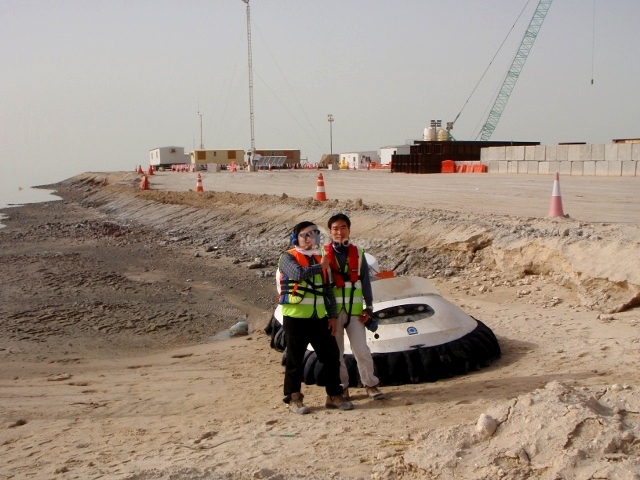 South Korean engineers Min Suk Lee and Seung Uk Paik South Korean engineers Min Suk Lee and Seung Uk Paik
begin a day of pilot training. On the following day, this training location was buried under layers of bulldozed sand.
|
Bubiyan Island sits at the mouth of the Tigris and Euphrates Rivers where they flow into the top of the Persian Gulf, a region known as the Shatt Al Arab, and consists of muddy silt deposited by the rivers for eons. The island’s shores are especially soupy but the inland terrain is baked hard from centuries under the Kuwait sun.
The Mubarak Al-Kabeer port is the largest construction project in the Gulf; the tender for the reclamation Phase 1 of this four-phase project was awarded to the South Korean firm Hyundai Engineering & Construction Co. Ltd. [Hyundai E&C]. It will be the largest container seaport in the Gulf and could rival Abu Dhabi and Dubai as a major transit hub between the Middle East, Europe and Asia. But the port is only the beginning of a 100-billion-dollar grand plan for the region.
Roadways and railways will connect the Mubarak Al-Kabeer port to Iran, Iraq, Saudi Arabia, possibly Turkey and other countries, where permitted. A 40 Km-long bridge is planned that will link Kuwait City with Subiyah on the northern side of Kuwait Bay, where Ecology and Environment, Inc. based their hovercraft operation in 2002. The plan is to transform the Subiyah area into a new city, a tourist haven that will allow entertainment and alcohol forbidden by the predominantly Muslim Kuwait City. To see this developing region from space, go to Google Maps and enter the coordinates 29.853429,48.304439.
A construction project of this size in this environment is a monumental feat, and the need for several hovercraft is clear. No other vehicle can carry personnel and equipment over this muddy moonscape quickly or perform rescues when emergencies arise. Surveying and sampling can be made a much easier and less time-consuming project when using hovercraft. Breaking down or getting marooned in this semi-liquid land makes rescue a slow, difficult task. Without hovercraft, all that can be done is to wait for the tide to change and hope the wind blows in the right direction so you might eventually float back to shore.
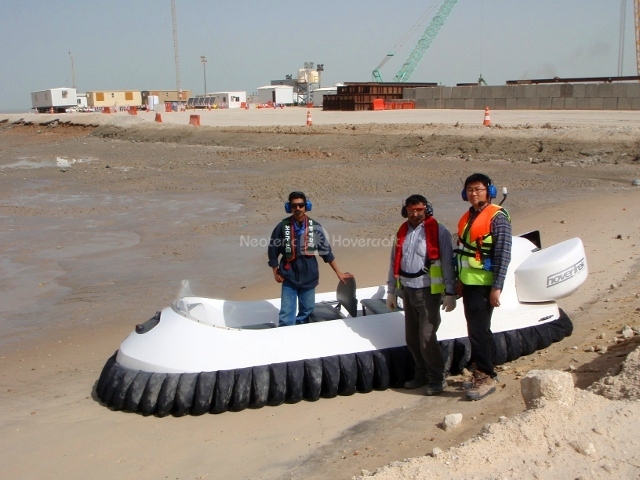 On the single favorable weather day of training, Aneesh Kumar, Saifull Islam and Min Suk Lee ready the hovercraft for shallow water and mud operation training. On the single favorable weather day of training, Aneesh Kumar, Saifull Islam and Min Suk Lee ready the hovercraft for shallow water and mud operation training. |
|
|
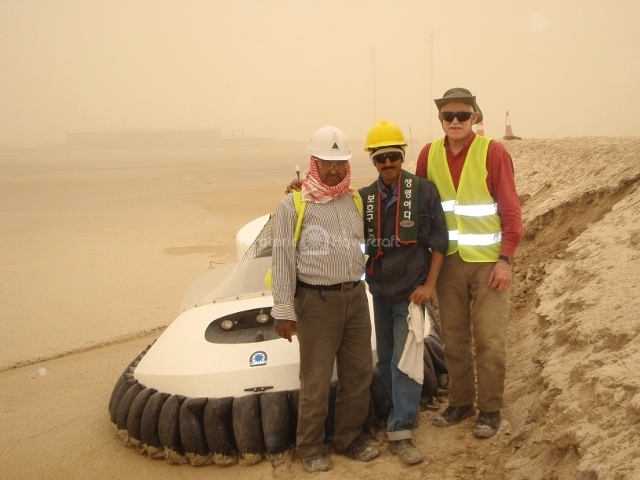 On another day, Saifull Islam and Aneesh Kumar ready for another day of training. The flying sand obscures the Hyundai headquarters in the background. On another day, Saifull Islam and Aneesh Kumar ready for another day of training. The flying sand obscures the Hyundai headquarters in the background. |
Both the terrain and the weather on Bubiyan Island made hovercraft training an interesting challenge. Nighttime temperatures can go below freezing and summer days can reach 155°F. There are frequent high winds and sandstorms. The intertidal zone is extremely shallow, from zero to 12 inches deep over large areas, with rough waves. The changing water content of the silt causes it to vary from slimy/slippery to viscous and sticky like clay. This treacherous surface requires expert piloting skills because it tucks the hovercraft skirt under so the craft rolls and can’t move. The Hovertrek’s reverse thrust is an asset in managing this problem.
The weather was temperate on only one day of training. On the other three days we were very cold and wet, working in 35 Km/Hr winds and sandstorms, with daytime high temperatures of 52°F. For each training session we had to determine a launch site that would still exist at the end of the session and not be buried by bulldozed sand.
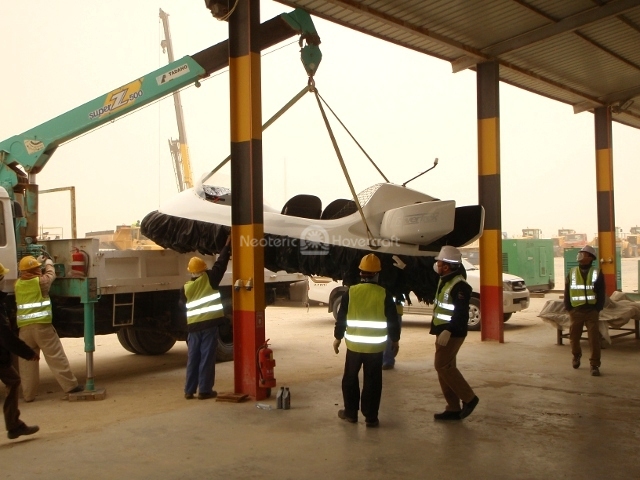 The Hyundai E&C hovercraft was purchased without a trailer so it had to be transported via boom truck, a slow and inconvenient process. The Hyundai E&C hovercraft was purchased without a trailer so it had to be transported via boom truck, a slow and inconvenient process.
|
We were not alone on this terrain during flight training. As far as the eye could see, the soupy silt was a mass of living creatures such as crabs and mud darters. These small mud dwellers stake out their own territories and their constant territorial disputes mirror the ones of those further up the food chain who are about to dump billions of tons of sand upon their disputed ancient habitat. As we hovered through their grounds, those in front would duck into the mud and pop up again as the craft passed, while on each side of the craft we had an audience of thousands of mud-bleary eyes watching us pass.
It is nearly impossible to relate the complicated nature of Hyundai E&C’s Phase 1 project. All materials must be transported 200 Km by truck from Kuwait City. Even the sand required to build up a stable surface is trucked from 150 Km away because local sands are geologically unsuitable. For the last couple of years more than a thousand 40-ton trucks have worked around the clock transporting sand to the eastern side of Bubiyan Island on the Khor As Subiyan.
Shortly after this herculean sand transportation project began, the only bridge across the Khor As Subiyan to Bubiyan Island failed, requiring an expansive fix. To keep things moving, a massive sand dump was established on the western Subiyah side of the bridge. A fleet of Cat and Komatsu bulldozers load smaller trucks for the bridge-crossing segment of the trip, which are unloaded on the other side of the bridge to create a second mountain. This process relieves bridge point loading and is a temporary solution to having to rebuild the bridge. The sand is then loaded onto larger trucks for the 45 Km trek over a rough, mud-packed road to the port construction site.
The activity at the port construction site is mind-boggling. Each day more than 1,000 trucks arrive fully loaded and depart empty. Sand and bulldozers are everywhere, along with 150-foot-high wick planting machines that drive plastic wicks 140 feet down through the mud. The wicks are connected just below the surface to 8-inch diameter plastic pipes which carry the water forced up through the wicks out to sea. These machines work around the clock and emit tortuous screeches that are especially noticeable at night.
After a large area is filled with wicks, 30 feet of rock overburden is dumped atop the entire area. The weight of the rock forces the 30 feet of sand downward and the water out of the silt 140 feet upward to the surface. After about six months the wicks stop working; the 30-foot rock overburden is then removed and the surface is compacted with heavy vibrating powered rollers. It takes all this to create the finished product: a concrete pavement.
The massive container terminal cranes are mounted on 1-meter-diameter steel pipes driven 150 feet down into the hard packed sand upon which Bubiyan Island rests. The pipes are partially filled with sand and topped off with concrete. More than 37 barges, ships, floating cranes and boats operate to dredge the perimeter. The dredge material (the home of the crab and mud darter hovercraft admirers!) is dumped into barges, brought to shore, unloaded by bucket scoops and trucked onto the land as additional fill material.
The logistics of providing supplies is equally unfathomable. Water, food, paper, gasoline fuel – everything must be transported from elsewhere to this enterprise. Hyundai E&C has established a village with comfortable, air conditioned and heated accommodations that include showers, an exercise and games room, and laundry services. There is a mess hall to feed the 300 South Korean engineers plus a second mess hall for the 500+ workers from India, Bangladesh, the Philippines and Pakistan. This is truly an international project; I met people from Britain, Egypt, Turkey, South Korea and even an Iraqi civil engineer who was actually from Kentucky. Strangely enough, I never met a Kuwaiti.
I was told that Iraqi Prime Minister Nouri al-Maliki visited the port construction site during my stay, but the magnitude of this project and the intensity of the pilot training were such that I could rarely see anything before me other than mud and blowing sand!
Hovercraft pilot training is a major focus of my life and one I thoroughly enjoy. But the next time I visit the Mubarak Al-Kabeer sea port I hope it will be on a luxury cruise liner with a small runabout hovercraft aboard to carry me up the waterway to the new tourist haven for lots of entertainment and a “wee” droup of scotch!
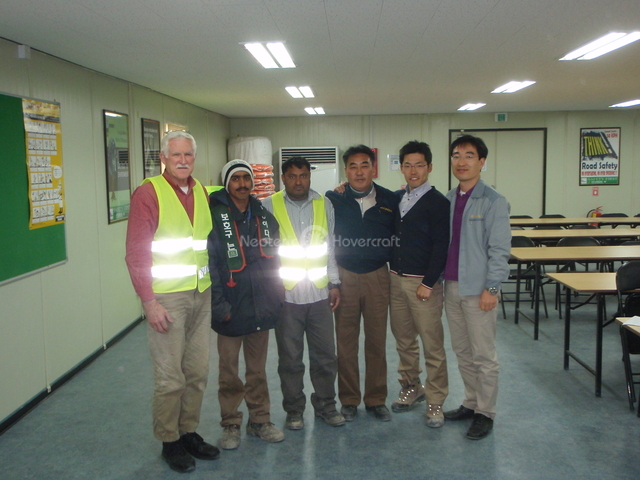 Hyundai E&C employees receive their Class III Hovercraft Pilot Certificates. Left to right: instructor Chris Fitzgerald; Speed Boat Operator Aneesh Kumar;
Speed Boat Operator Saifull Islam; Marine Operation Manager Cpt. Tae Young Kim; Asst.Senior Engineer/Hovercraft Project Leader Seung Jong Ki; Scheduling Engineer Seung Uk Paik;
Civil Engineer Min Suk Lee; and (not shown) hovercraft mechanic Muhammad Asad Jaman Ali. Hyundai E&C employees receive their Class III Hovercraft Pilot Certificates. Left to right: instructor Chris Fitzgerald; Speed Boat Operator Aneesh Kumar;
Speed Boat Operator Saifull Islam; Marine Operation Manager Cpt. Tae Young Kim; Asst.Senior Engineer/Hovercraft Project Leader Seung Jong Ki; Scheduling Engineer Seung Uk Paik;
Civil Engineer Min Suk Lee; and (not shown) hovercraft mechanic Muhammad Asad Jaman Ali.
|
|